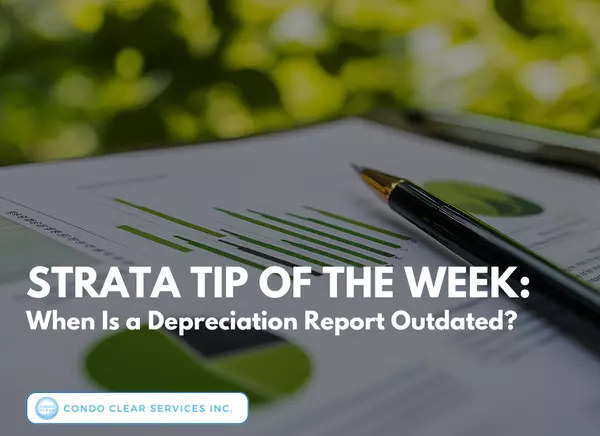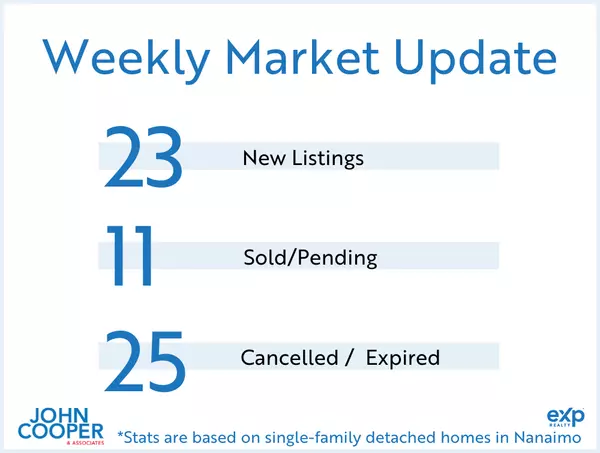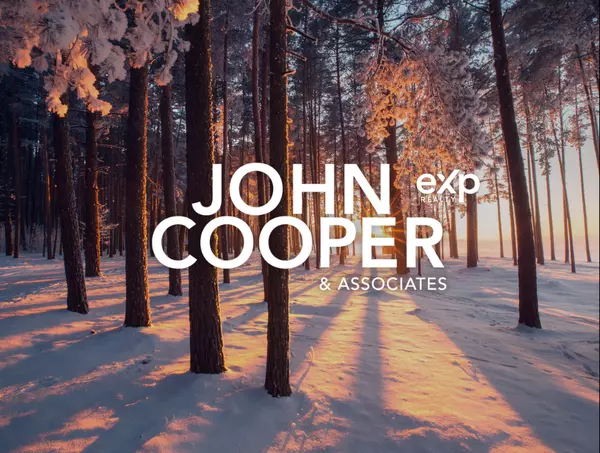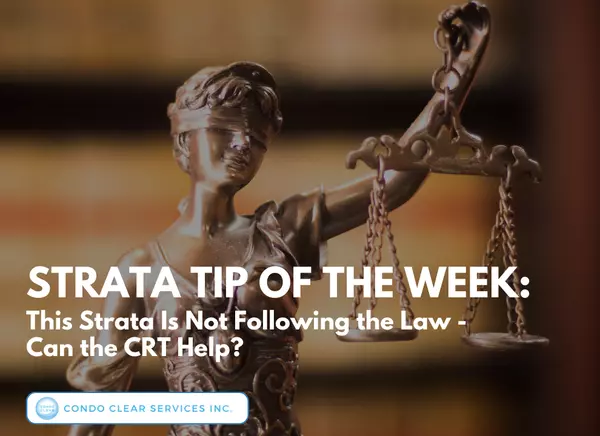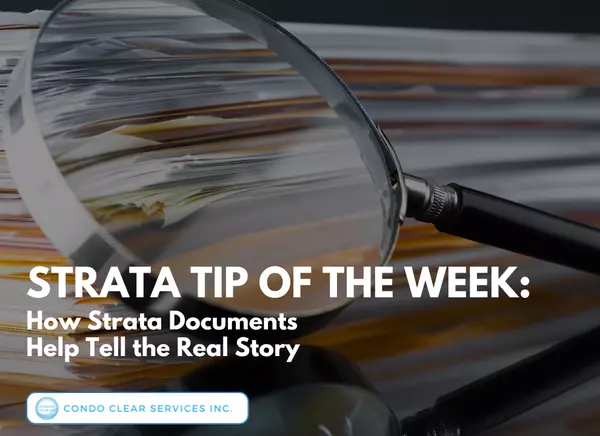Strata Tip of the Week – How Strata Documents Help Tell the Real Story
When you buy a strata property, you’re not just buying the unit. You are also buying into the finances, maintenance history, governance, and long-term planning of the entire strata corporation. And a significant part of that story is reflected in the strata’s documents.
At Condo Clear, we’ve reviewed strata documents from thousands of corporations across British Columbia. We work with strata owners, council members, buyers, Realtors, and other stakeholders to help them understand when documents are incomplete, what information they reveal, and how those insights fit into the bigger picture.
Missing and Incomplete Strata Documents
The most common issue we see when evaluating a strata corporation is incomplete or missing documents. More than 95% of the document packages we receive are missing key items or contain outdated, incomplete, or illegible information. Starting with a complete set of documents is one of the simplest ways to reduce surprises and make informed decisions, whether you’re a buyer, owner, or Realtor.
To help with this, we’ve created a free Condo Clear Strata Documents Checklist that outlines the documents we recommend you obtain and review when you want a thorough understanding of a strata corporation. You can access the free checklist here: Condo Clear Strata Documents Checklist
Having this list in place is the first step. From there, the real value comes from understanding what these documents reveal about the strata’s overall health and long-term planning. Here’s a quick overview of what these documents can tell you:
1. Form B: Information Certificate
The Form B is a document that buyers typically obtain when purchasing a strata titled property. It’s completed by the strata or its management company and includes information such as monthly strata fees, any outstanding amounts owing, special levy payments due, parking and storage details, and whether the strata is involved in legal proceedings.
The Form B is a snapshot of the strata’s records at the moment it’s prepared. Any of the information can change immediately afterward. To reduce the risk of relying on outdated details, we always recommend obtaining a Form B that is no older than one month.
2. Budget and Financial Statements
Budgets and financial statements are an essential part of understanding a strata’s financial health. They provide insight into how the strata has performed in the past, how well it’s operating and prioritizing today, and how effectively it’s planning for the future.
To gain a clear picture, we recommend reviewing the current and previous fiscal year budgets, the year end financials for the past two fiscal years, and, if available, the most recent monthly financials.
3. Depreciation Report
A depreciation report outlines the major components of the building, their estimated remaining life, and the projected cost of repairs and replacements over the next 30 years. It also provides funding models that help guide the strata’s long-term planning, although strata don’t actually have to follow any of those funding models.
For buyers and owners, the depreciation report offers essential insights into upcoming projects and whether the strata is setting aside enough funds to pay for them. A well-prepared report helps reduce surprises and supports informed financial decisions and planning.
4. Insurance Certificate
Insurance is all about understanding and mitigating risks. The strata’s insurance certificate outlines the strata’s coverage, limits, and deductibles, and helps owners and buyers understand:
- Whether the building is adequately insured
- How high key deductibles are
- Whether the strata has earthquake insurance
- Any other exclusions or conditions that affect risk
Reviewing the strata’s insurance policy helps clarify what coverage the strata has in place and what additional personal insurance you may want or need in order to protect yourself from risks that are not covered by the strata’s policy.
5. Bylaws and Rules
Every strata operates under the Schedule of Standard Bylaws or its own set of bylaws, and many stratas also have rules. These documents outline how the strata is governed and set out the rights, restrictions and responsibilities for owners, tenants, and visitors.
Because we often find that strata document packages include outdated bylaws, we recommend obtaining the registered bylaws and all filed amendments directly from the Land Title Office. As for the rules, these must be attached to the Form B.
6. Strata Plan and Schedule of Unit Entitlement
The strata plan helps you understand what forms part of the common property, limited common property, and the boundaries of each strata lot. It’s also helpful for verifying information such as how parking and storage areas are designated.
The schedule of unit entitlement determines each unit’s share of common expenses (e.g. strata fees, special levies, shared deductibles, etc.).
- For plans filed before July 1, 2000, the schedule is included on the strata plan.
- For newer plans, it’s a separate document known as the Form V: Schedule of Unit Entitlement.
At Condo Clear, we frequently see errors in how strata fees are calculated. Reviewing the schedule of unit entitlement helps ensure that owners are paying their correct share.
7. General Meeting Notice Packages and Minutes
While it’s standard for buyers to review general meeting minutes when purchasing a strata-titled property, it’s less common to request the general meeting notice packages. As most strata owners know, these notice packages often contain important information that does not appear in the minutes, such as budgets, financial statements, council reports, engineering and other professional reports, and contractor quotes.
The team at Condo Clear always recommends obtaining and reviewing both the general meeting minutes and the notice packages. Together they help you better understand the strata’s key challenges and priorities and how owners make decisions about budgets, bylaws, and major projects.
8. Strata Council Meeting Minutes
Strata council minutes help show how the strata is run on a day to day basis. They provide insights into maintenance issues, repairs, insurance claims, disputes, and ongoing projects. They also highlight positive developments such as completed maintenance, improvements, and community events.
Reviewing two years of council minutes has become industry standard. It helps identify patterns, shows how the council operates, and provides a clearer picture of the strata’s overall condition and day-to-day management.
9. Professional Reports, Warranty Certificate, and Correspondence
Professional and engineering reports offer a more detailed look at the building’s components. When available, they often identify issues or recommendations that may not appear in the minutes or other documents.
For newer buildings, the warranty certificate outlines what parts of the building are still under warranty and for how long. As those warranty periods end, more costs can shift to the owners, so it’s important to understand these timelines and ensure the strata is taking advantage of its warranties before the coverage expires.
Finally, any correspondence related to the unit can reveal disputes, repair concerns, noise issues, or compliance problems that might affect a buyer’s decision.
Seeing the Full Picture
Each strata document offers one piece of the story, but reviewing them together provides a far clearer understanding of how the strata is managed, how it’s performing financially, and what you can expect in the years ahead. Whether you are buying, selling, or already living in a strata, having the full set of documents and knowing how to interpret them is one of the most reliable ways to avoid surprises.
At Condo Clear, we review strata documents every day and share these insights to help buyers and owners feel more confident navigating strata living. Sign up for our Strata Tip of the Week Newsletter to stay up to date with the latest strata news and articles.
That’s it for this week. If you have any suggestions for other topics you’d like us to cover, please let us know at info@condoclear.ca.
Author: Ryan Stenquist and Mugurel Mic; Last Edited: November 21, 2025
© 2025 Condo Clear Services Inc. All rights reserved. You may share this post, but you may not copy, modify, or use it commercially without permission. For permission, please contact us.
Disclaimer: The information provided is for general purposes only. It is not intended to provide legal advice or opinions of any kind. No one should act, or refrain from acting, based solely upon the materials provided, any hypertext links or other general information without first seeking appropriate legal or other professional advice.
A little about Condo Clear:
They are a fully licensed brokerage under the BCFSA, and carry Errors and Omissions (E&O) insurance.
They have been in business since 2017 and have completed over 3,000 strata reviews to date province-wide.
Their Review Advisors have firsthand knowledge and experience. They’ve all been practicing strata managers.
FAQs: How do Condo Clear’s services work?
Pricing: How much do Condo Clear’s services cost?
Learn More: https://condoclear.ca/
Categories
Recent Posts

